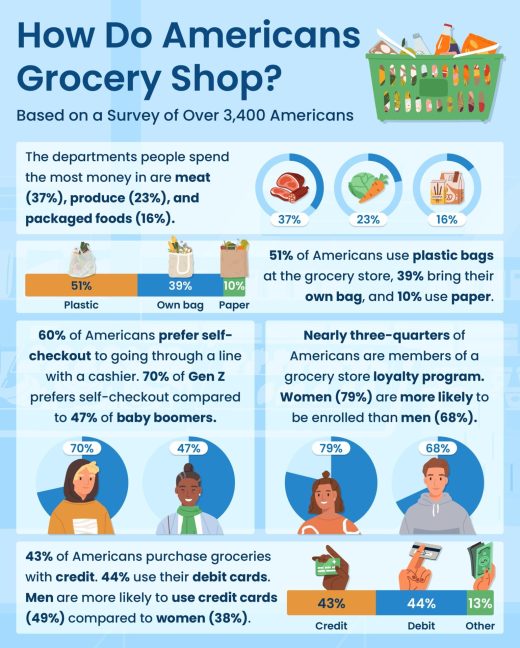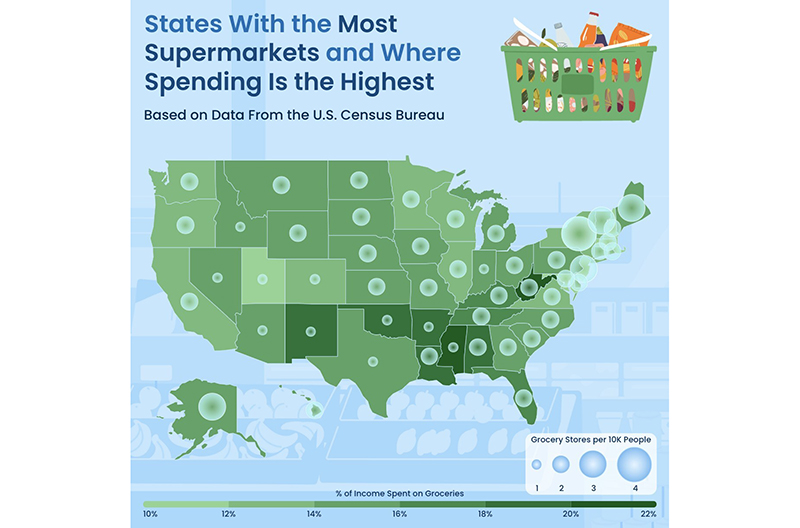The latest research from Upgraded Points finds that 80 percent of Americans will see their grocery bills increase this holiday season, with 65 percent shopping more frequently during this time.
The report explores these holiday spending habits and the regional differences in grocery shopping, delving into factors such as store density and budgeting to provide a comprehensive look across the United States.
“Grocery spending is a part of every household budget, yet how much Americans spend and where they shop can vary dramatically depending on their state and the time of year,” said Keri Stooksbury, editor-in-chief at Upgraded Points.
“Understanding how much of someone’s income goes to groceries and what their access to grocery stores is like can provide valuable insights into people’s everyday lives, particularly around the holiday season.”
To determine the parts of the country that spend the most on groceries and where store access is highest, the study analyzed data from the census on grocery spending and density in every state, normalizing those points against median income and population to allow for more accurate comparisons across states.

The study also surveyed more than 3,400 Americans to get insight into their typical grocery shopping habits and how much more they spend on groceries during the holiday season.
How much do grocery bills increase during the holidays?
These states see the largest spikes in grocery spending during the holiday season:
- Hawaii – 29.8 percent;
- Montana – 28.3 percent;
- Tennessee – 28.2 percent;
- Virginia – 27.9 percent; and
- Texas – 27.7 percent.
Hawaii leads the pack, which isn’t too surprising given its higher cost of living and reliance on imported goods that can make seasonal splurges pricier.
Meanwhile, Texas’s size and culturally diverse holiday traditions likely contribute to residents going all out at the grocery store.
States that spend the most of their income on groceries
Of those surveyed, 88 percent say their grocery costs have risen over the past year, and 93 percent report higher bills over the past three years.
- Mississippi – 21.1 percent of income;
- West Virginia – 20.2 percent;
- Louisiana – 19.9 percent;
- New Mexico – 19.7 percent; and
- Alabama – 18.4 percent.
It’s no surprise that states topping this list tend to have lower median household incomes. Regional trends suggest that Southern states, where incomes tend to be lower than national averages, feel the impact of grocery spending more sharply.
States that spend the least of their income on groceries
- New Hampshire – 10.7 percent
- Maryland – 11.2 percent
- New Jersey – 11.4 percent
- Massachusetts – 11.5 percent
- Utah – 11.8 percent
Higher-income states dominate this list, where groceries account for a smaller percentage of household income. They spend nearly half as much of their income as states on the higher end of the ranking.
Utah stands out as the only western state, which could be due to its comparatively lower grocery costs and larger average household sizes that benefit from economies of scale.
States with the most grocery stores (per 10,000 residents)
- New York – 4.3
- Vermont – 3.3
- Alaska – 2.9
- Maine – 2.6
- New Jersey – 2.6
New York has the highest grocery store density at 4.3 stores per 10,000 residents, reflecting its urban centers such as New York City, where accessibility to them is a necessity.
States with the fewest grocery stores (per 10,000 residents)
- Arizona – 1.1
- Nevada – 1.1
- Utah – 1.1
- New Mexico – 1.2
- Texas – 1.2
The Southwest dominates the lower extreme of this list, reflecting the region’s sprawling suburbs and larger distances between population centers.
States such as Texas and Arizona, known for their expansive geographies, often consolidate grocery stores into larger chains serving wider areas. This lower density may force residents to drive farther for groceries, impacting convenience and potentially influencing spending habits.
To explore specific insights about how Americans grocery shop, including checkout preferences and payment trends, visit the full study online.
About Upgraded Points
Launched in 2016 by Alex Miller and headquartered in Austin, Texas, Upgraded Points uses targeted research efforts and in-depth studies to help travelers maximize their travel, points and experiences.

